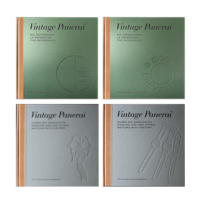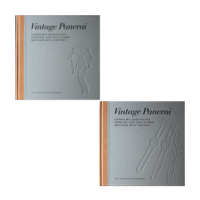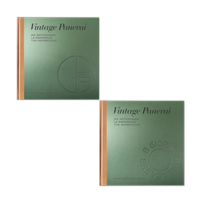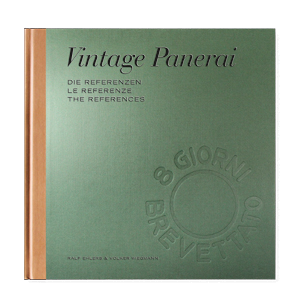Author Archive
Photo series “Vintage Panerai instrument of the week”
by Volker on Sep.30, 2010, under General
 Ralf came across a very interesting instrument with a rotating scale: A so called “Congegno S.M.1” – 20 minute timer, which can be attached to an explosive source. The black coated case shows the typical engraved font (white numbers 20, 15, 10 and 5) which have been used on other Panerai instruments.
Ralf came across a very interesting instrument with a rotating scale: A so called “Congegno S.M.1” – 20 minute timer, which can be attached to an explosive source. The black coated case shows the typical engraved font (white numbers 20, 15, 10 and 5) which have been used on other Panerai instruments.
Not much informations available yet, but something to discover in the future – as it is described as a prototype on its outer box, there were probably not made too many of this type…
“Time and Space: a Tribute to Galileo Galilei”
by Volker on Sep.24, 2010, under General
Just found this press release in the web today, highly recommended:
Officine Panerai returns to Florence, its city of origin, to celebrate a history of values and technical excellence that is unique in the world of leading watchmakers with an exhibition-event. “Time and Space: a Tribute to Galileo Galilei” is the title of the exhibition set up at Ex3 – Contemporary Art Centre from 27th September to 2nd October 2010, where Officine Panerai will be displaying a collection of the most important watches and instruments from its historical and contemporary collections for the first time. The show culminates with the display containing an “astronomical” triptych made by Officine Panerai as a tribute to Galileo Galilei on the 400th anniversary of his first celestial observations.
The exhibition goes into three phases in particular, covered by the three sections of the display. The first is history and it uses selected items from the Panerai Museum to document the development and success of the Panerai brand from a Florentine workshop to a leading supplier of precision instruments to the Italian Navy.
The second section deals with the success achieved by the brand worldwide, following the acquisition by the Richemont Group in 1997 – a large hall houses the watches that are most emblematic of the 13 years over which Officine Panerai renewed the glorious history of its brand’s icons: Luminor and Radiomir series watches.
The third section is dedicated to a Tribute to Galileo Galilei, the genius to whom Officine Panerai, in the name of the common Tuscan ancestry and of a love for science and innovation, has dedicated an “astronomical” triptych in 2010, made up of three exceptionally sophisticated models: the Astronomo (Luminor 1950 Equation of Time Tourbillon Titanium – 50 mm), the Scienziato (Radiomir Tourbillon GMT Ceramic – 48 mm) and the Panerai Jupiterium planetary clock.
Location:
 OFFICINE PANERAI
OFFICINE PANERAI
“Time and Space: a Tribute to Galileo Galilei”
September 27th to October 2nd 2010
(closed on Tuesday 28th) from 10 am to 7 pm
EX3 – Contemporary Art Centre
Viale Giannotti 81/85 – Firenze
The Rolex Cal. 618 with Incabloc: “Type 4″
by Volker on Sep.20, 2010, under General
 Nice detail view of a Rolex Cal. 618 / Type 4 movement, working accurate in a 6152/1 “Luminor Panerai” watch.
Nice detail view of a Rolex Cal. 618 / Type 4 movement, working accurate in a 6152/1 “Luminor Panerai” watch.
The characteristic features of the Type 4 movement are:
17 Rubis, Incabloc shock protection
(balance cock engraved with a “plus-minus scale”)
16 Lines, power reserve approx. 36 hours.
18.000 half-oscillations per hour.
You can read and see more about the different versions of Rolex Cal. 618 movements in Panerai watches in our 2nd book “Vintage Panerai – The References”.
Photo series “Vintage Panerai instrument of the week”
by Volker on Sep.18, 2010, under General
 Tried to catch some details of a depth gauge’s meter hand today. The “Luminor” elements (markers and numbers on the dial, tip of the hand) still glow in a strong green color when under influence of direct light – quite impressive for a tool of this age and very different to the instruments with “Radiomir” elements.
Tried to catch some details of a depth gauge’s meter hand today. The “Luminor” elements (markers and numbers on the dial, tip of the hand) still glow in a strong green color when under influence of direct light – quite impressive for a tool of this age and very different to the instruments with “Radiomir” elements.
The shown depth gauge is calibrated to 16 meters. There exist many other versions for various dephts, depending on their use (attack or defense).
More informations about this Panerai instrument can be found in chapter III of our 1st book “Vintage Panerai – Watches with History”.
Spot on: 6152!
by Volker on Sep.10, 2010, under General
 Everytime we get the chance to take a close look at a rare Ref. 6152 Panerai, we can’t resist to make a very close observation of its case profile, which is – compared to Ref. 6152/1 case profile – very different. During the X Club Panerai Meeting in Viareggio there was another chance to take a close look at a collector’s stunning Ref. 6152 watch (see illustration on the left).
Everytime we get the chance to take a close look at a rare Ref. 6152 Panerai, we can’t resist to make a very close observation of its case profile, which is – compared to Ref. 6152/1 case profile – very different. During the X Club Panerai Meeting in Viareggio there was another chance to take a close look at a collector’s stunning Ref. 6152 watch (see illustration on the left).
Both references were delivered with 8 mm Rolex crowns, but the main feature of the better known (and more produced) Ref. 6152/1 is the Panerai crown protecting device. For many collectors it is difficult to understand the difference between a Ref. 6152 and a Ref. 6152/1 if they only see photos of both references.
If you ever have the chance to hold a Ref. 6152 Panerai watch in your hand: you must see and feel the small hollow and the slope (pink colored in the illustration) on the side of the case. If you compare it with the rounded case profile of a 6152/1, the difference is very clear and easy to spot.
You can read more about the Ref. 6152 Panerai in chapter II of our 2nd book “Vintage Panerai – The References” with detailled dimensions and supporting photos, comparing all three 615X references and their differences.
6152, 6154 and 6152/1 caseback classification
by Volker on Sep.09, 2010, under General
 The references produced in the 1950’s and 1960’s show clearly differences in caseback markings. Beside the different shapes of center cases and lugs between 6152, 6154 and 6152/1, different Rolex markings are visible when caseback removed.
The references produced in the 1950’s and 1960’s show clearly differences in caseback markings. Beside the different shapes of center cases and lugs between 6152, 6154 and 6152/1, different Rolex markings are visible when caseback removed.
The illustration shows the following caseback versions:
Ref. 6152 Rolex (with case number)
Ref. 6154 Montres Rolex S.A. (with case number)
Ref. 6152/1 Montres Rolex S.A. (without case number)
You can read and see more about the different versions of Ref. 615X watches in our book “The References”.
3646 caseback classification (Type A – Type C)
by Volker on Sep.08, 2010, under General
 An example of our classification work: The reference 3646 is divided into seven production groups (Type A – Type G), of which the different caseback markings and numbers (inside) are just one of the most important indicators.
An example of our classification work: The reference 3646 is divided into seven production groups (Type A – Type G), of which the different caseback markings and numbers (inside) are just one of the most important indicators.
The illustration shows the following caseback versions:
Ref. 3646 / Type A Oyster Watch Co (large)
Ref. 3646 / Type B Oyster Watch Co (small)
Ref. 3646 / Type C Brevetee Rolex S.A.
You can read and see more about the different versions of Ref. 3646 watches in our 2nd book ““The References” 1930’s-1940’s.
3646 / Type B number group expanded to 1010024
by Volker on Sep.06, 2010, under General
Recently we added another Ref. 3646 / Type B watch into our database.
It expands the number group of today existing Type B watches from 1010015 to 1010024.
Typical features of Ref. 3646 / Type B watches are the small “Oyster Watch Co” stamp in the inner caseback and the Rolex Cal. 618 / Type 1 movement.
Happy Birthday, paneristi.com!
by Volker on Sep.01, 2010, under General
September 1st, 2010: today www.paneristi.com is celebrating the 10th anniversary.
Thanks to the owners, moderators and all the collectors around the world, who make this website a great place to talk about Panerai watches!
[Ralf Ehlers & Volker Wiegmann]
The Rolex Cal. 618 with Incabloc: “Type 3″
by Volker on Aug.27, 2010, under General
 Used in the minority of Ref. 6152/1 watches, the Rolex Cal. 618 / Type 3 movement comes with 15 jewels and the Incabloc shock protection. It was another development to improve the quality of the movements, after earlier Ref. 6152 watches held 15 jewel movements without the Incabloc feature. The escapement bridge is similar like on Rolex Cal. 618 / Type 2 movements, typical for movements powered with 15 jewels.
Used in the minority of Ref. 6152/1 watches, the Rolex Cal. 618 / Type 3 movement comes with 15 jewels and the Incabloc shock protection. It was another development to improve the quality of the movements, after earlier Ref. 6152 watches held 15 jewel movements without the Incabloc feature. The escapement bridge is similar like on Rolex Cal. 618 / Type 2 movements, typical for movements powered with 15 jewels.
Compared to the Rolex Cal. 618 / Type 4 movement, which is used in most of the 6152/1 watches, the engravings on the movement bridges show clear differences. The “ROLEX” and “FAB. SUISSE” engravings changed their positions. The “SWISS MADE” engraving and the engravings of the jewels used (“15 RUBIS” on Type 3 / “17 RUBIS” on Type 4) changed positions as well.
You can read and see more about the different versions of Rolex Cal. 618 movements in Panerai watches in our 2nd book “Vintage Panerai – The References”.





